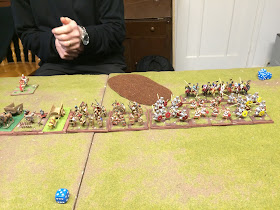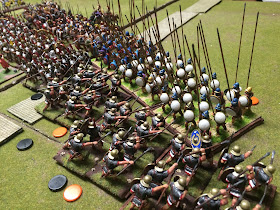Following his victory at Heraclea, Pyrrhus recruited a number of Greek and Italian allies to his cause and then set off towards Rome, but found way blocked by troops under the command of Consules Decius and Sulpicius. Not wishing to pass-up the some comedy potential they were rapidly christened Antius and Decius for our refight.
Pyrrhus force was a polyglot one consisting of elite pikes (FV8), allied pikes (FV7), Greeks (FV6), and raw Italians (FT 5 [1] 1), with the usual supporting cavalry and the elephants. Pyrrhus massed massed pikes in the centre, with the mounted/elephants on the right and the Italians holding the left. He looked set for a defensive battle, seeking to draw the enemy onto his pikes.
 |
| Italians and peltasts on Pyrrhus left |
 |
| The main phalanx |
 |
| The right featuring the mounted |
The Romans had a large force of heavy infantry with mainly Romans/Latins (FV7) and a few Italians (FV6), with cavalry and plentiful skirmishers in support. For this battle they also field anti-elephant wagons which we treated as Scythed Chariots ( 5 [0] 0 and 1 BP), which we placed under the command of Antius for obvious reasons! The Romans were planning a general advance with a hope of winning on the flanks where the cavalry and Triarii were deployed.
 |
The Roman left, ready to take on the elephants
|
 |
| Roman centre - not much to say! |
 |
| The right facing off the Italians |
Both sides began with an advance on the flanks seeking to gain an early advantage against the enemy. The deployment favoured Romans on their right but the same was true of Pyrrhus deployment on hist right.
 |
| Pyrrhus left moves off |
 |
| His right also advances |
 |
| The elite pikes move up in support |
In an early part of the battle Antius' anti-elephant wagons went careering across the table towards the Successor cavalry, creating a small dent (knock-for-knock job) before being annihilated, leaving a hole in the line.
 |
| Wagons roll! |
 |
| hmm - that did nt last long |
On their right the Romans scored an early victory by routing the Greek light horse, exposing the peltasts to a heavy cavalry charge. In a pincer movement this quickly destroys both peltasts leaving the raw Italians unsupported. Whilst the Successors left looks in trouble their cavalry inflicts damage on the advancing Romans and opens-up a possible flank attack of their own on their right.
 |
| Roman HC eye-up the peltasts |
 |
| Triarii look to slow the cavalry attack |
 |
| Italians on the march |
The Romans reposition though and are able to attack the elephants with light troops, making short work of them. On their left the Triarii move up to oppose the advancing Italians and quickly blunt the attack.
 |
| Elephants in a spot of bother |
 |
| The Triarii assault the Italians |
As the main lines come to grips its pretty much nip and tuck with no clear winner from the initial clash of legion with phalanx.
 |
| Elite pikes advancing steadily, but under threat on the flanks |
 |
| Legion vs phalanx |
Crucially for the Romans their cavalry arrive in the nick of time to pin the advancing Italians and prevent them attacking the Triarii's, which allows them to break through the lines.
 |
| Roman horse make a timely arrival |
The elite pikes now found themselves trapped between the Latin allied legions and the Roman heavy cavalry. In this position there was little hope and they succumbed bravely.
 |
| Elite pikes caught in a trap |
 |
| Shove! |
Over on their own right the Successors were finally able to free their Companion cavalry but to late to affect the outcome. The result was a decisive 8-1 victory for Rome - truly a Pyrrhic defeat.
 |
| Finally in position but its all over |
The post-match analysis was that the Successor left flank was too weak to withstand the Roman forces opposite them, meaning the flank of the phalanx was always at risk. Some bad luck on the dice making this happen quicker than may have been expected.






















No comments:
Post a Comment